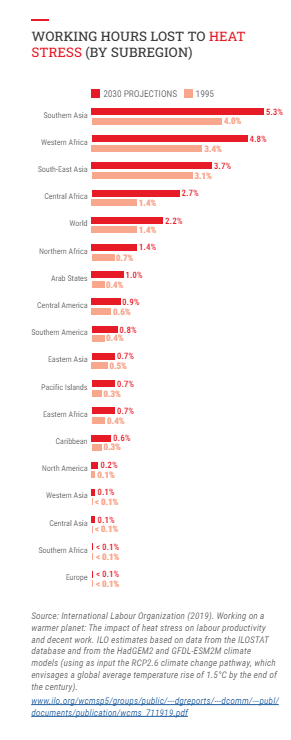A recent International Labour Organization (ILO) report highlights the alarming reality of climate change’s impact on the global workforce. The ILO estimates that “more than 2.4 billion workers, or more than 70% of the total 3.4 billion global workforce, are likely exposed to excessive heat at some point during their work.”
Climate change poses a significant threat to the health and well-being of outdoor workers, with 70% of the world’s workforce facing a “cocktail” of serious health hazards. This includes increased risks of cancer, cardiovascular disease, respiratory illnesses, kidney dysfunction, and mental health conditions. These health hazards are a direct result of climate change, which exposes workers to extreme temperatures, air pollution, and other environmental stressors.
The impacts are far-reaching and will affect all developed and developing countries globally. The ILO reports highlight the impact includes:
- 1.6 billion workers are exposed to UV radiation, with more than 18,960 work-related deaths annually from nonmelanoma skin cancer.
- 1.6 billion people are likely to be exposed to workplace air pollution, resulting in up to 860,000 work-related deaths among outdoor workers annually.
- Over 870 million workers in agriculture are likely to be exposed to pesticides, with more than 300,000 deaths attributed to pesticide poisoning annually.
- 15,000 work-related deaths every year due to exposure to parasitic and vector-borne diseases.
Ever Increasing frequency and intensity of Heatwave
One of the biggest factors of climate change’s impact is the ever-increasing frequency and intensity of heat waves worldwide. A recent UN report on heatwaves highlights the increasing threat of heatwaves due to climate change.
The consequences of heatwaves are alarming and devastating, and climate change is escalating the dangers of extreme heat at an unprecedented rate. Already, outdoor laborers are paying the highest price for their lives, health issues, and loss of income due to lost working hours. Furthermore, the impact is not limited to wealthy nations; developing countries in Africa, Asia, and Latin America have recently faced severe heat-related crises. In fact, wherever reliable data exists, heatwaves are the most lethal weather-related threat.
Moreover, another UN report suggests despite 2023 being the hottest year on record, public funding for climate change adaptation has decreased. This funding gap poses significant challenges for developing countries, particularly in the Global South.
The industries and urban functions heavily rely on outdoor laborers who face prolonged heat exposure but often lack access to essential protections like regular breaks, cooling measures, or the flexibility to adjust their work schedules or take days off.

What is at stake? Outdoor industries will suffer the most.
The recent heat waves in Southeast Asia and unprecedented rains in Dubai, Oman, the Philippines, and Brazil halted economic activities in major cities. The vulnerable regions are the Middle East, mainly Saudi Arabia, UAE, and Qatar, as well as developing economies like India, Bangladesh, Pakistan, and Nigeria.
The construction industry, traditionally connected to thirty other major industries, can be a good example of assessing the impacts of climate change hazards on outdoor industries. Developing countries are in dire need of infrastructure development and are also facing a more severe impact of climate change. Any delays in mega-infra projects greatly impact the payback period, interests, and political implications of delivering the projects on time and at a high cost.
Some specific challenges the construction industry may face due to climate change hazards are lost working hours, resulting in project delays and lost productivity. Extreme weather events further add disruptions in the supply chain, transportation, and logistics, leading to material shortages and delays. The construction and infrastructure projects will encounter challenges of increased cost, workforce health and safety issues, potential liabilities, decreased productivity, and efficiency. Furthermore, the long-term damage to business continuity, reputation, and viability of construction projects, particularly those in high-risk areas. All these factors will contribute to project cost overruns and delays.
Companies, especially the outdoor industries, must take proactive measures to mitigate these climate change risks and hazards to protect their most valuable asset – their people. Climate change may lead to new building codes and regulations and health and safety, requiring adaptations in construction practices.

The way forward
The most affected countries, the Global South, will face the heaviest impacts of climate change that will be far-reaching and devastating, from intense natural disasters to chronic changes in weather patterns, affecting not only business operations but also the well-being of employees, customers, and the wider community
As climate change hazards, specifically the heatwaves, continue to devastate communities worldwide, it’s clear that a locally-driven, data-informed, and collaborative response is crucial to protect the most vulnerable
Outdoor industries must assess their vulnerabilities and prioritize developing strategies to adapt to the changing climate, investing in sustainable practices and resilient workforce training. Companies need to protect their outdoor workforce from climate-related hazards by reinventing their health and safety strategies. Traditionally, companies conduct health and safety assessments on every major job on site. Climate risk assessments should be added to identify potential climate-related hazards and assess the risks to workers. Implementing heat stress management plans to provide shade, water, and regular breaks to prevent heat-related illnesses. Climate-related emergency response plans must be incorporated into health and safety plans and communicated accordingly for responding to climate-related emergencies. Furthermore, training workers on climate-related hazards can effectively educate workers on recognizing and responding to climate-related risks.
By taking a proactive and forward-thinking approach, businesses can reduce the impacts of climate change hazards, minimize risks, and ensure a thriving work environment for the current and future workforce. Furthermore, companies prioritizing reducing climate-related hazards for their workforce will likely gain a competitive advantage, attract environmentally conscious customers and investors, and contribute to a more sustainable and equitable future for all.








